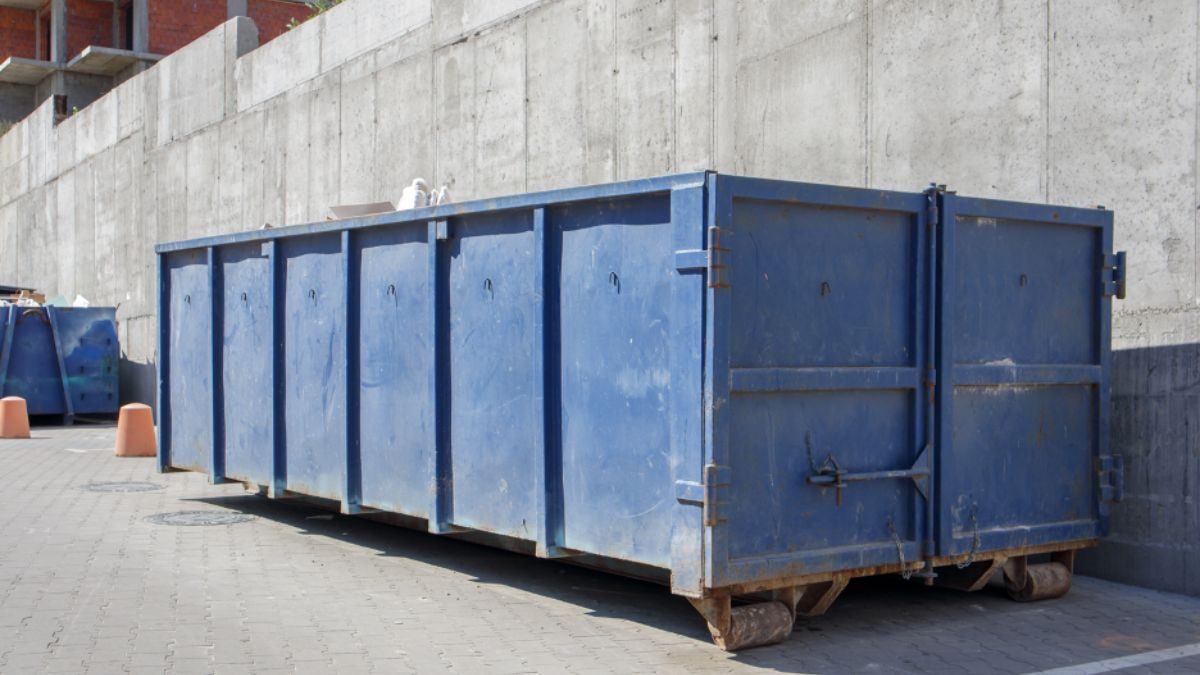BUSINESS
Reading Dumpster Sizes Chart and the Right Application for Each Size

Are you finding it hard to decide which dumpster size will be best? Checking the dumpster sizes chart of the rental company for detailed information may help. For more in-depth knowledge, read the section below.
Information on Dumpster Capacities
You’ll get rental dumpsters in multiple sizes. The small dumpsters work well for regular cleaning projects. If it’s a bigger project, having a larger unit is mandatory. Here, you must note that the numbers on the size chart don’t indicate the containers’ length. Instead, they refer to the containers’ internal storage capacity, and the unit used is cubic yards.
Every dumpster also has a specific weight limit. Here are a few examples:
- 10 Yard containers: Handling capacity of 1 to 2 tons
- 15 Yard containers: Handling capacity up to 3 tons
- 20 Yard containers: Handling capacity up to 4 tons
- 30 Yard containers: Handling capacity up to 5 tons
- 40 Yard containers: Handling capacity of more than 5 tons
Things to Know About Dumpster Dimensions
The dimensions of these containers tend to vary according to the manufacturer. The size that varies most in dimension is the 10-yard dumpster. Know more about the variations available from the list below:
- Length can be between 11.5 ft and 16 ft
- Height can be between 3 ft and 5 ft
- Width can be between 6 ft and 8 ft
Remember that the above dimensions will only tell you whether the container will fit the space available at your project site. The handling capacity of a 10-yard unit will remain 10 cubic yards. Usually, if a container’s length is short, it is taller and wider. Containers of other sizes have standardized dimensions. Their lengths range between 16 and 22 feet. They are all 8 feet wide. Lastly, their heights range between 4 and 8 feet.
Always, check the exact dimensions of the container you are renting. Make sure the container passes through your driveway without any difficulty. Here, you must note that you will need to open the dumpster’s back door to put in some large items. For that, the space must have an additional 8 ft.
People rent dumpsters to transport debris safely. You must avoid filling your dumpsters above their brim as roll-off units need to be covered. Buying a container of the right size will ensure you don’t need to overfill it. Arrange the debris in a way so that the top of the container remains relatively flat. It will ensure that the debris doesn’t fall off when being taken to the landfill.
When Should You Rent a Small Dumpster?
Rent a small dumpster only if it’s a minor home project and you know that the project will not produce debris more than a certain quantity. You can get a 10-yard container for jobs like disposal of tree limbs and leaves, remodeling of small spaces like your bathroom, etc. One of the main benefits of small dumpsters is that their sizes are perfect for most residential driveways.
Rent a 15 or 20-yard container if your home improvement or cleaning project produces slightly bulkier or heavier debris. This advice would work for kitchen remodeling projects where the homeowner doesn’t have enough time to dismantle the racks and cabinets.
When Should You Rent a Large Dumpster?
Go for a large unit if it’s a serious home remodeling project. You’ll need these bigger units even when performing large-scale cleaning and of course during construction works. A larger container will be able to accommodate and handle big and bulky items like building materials, flooring, furniture, etc.
You should consider renting a big dumpster even if your project produces debris that is heavier than what a small dumpster is designed to handle. For example, you shouldn’t go for a small unit if the debris includes heavy materials like asphalt and concrete.
You Must Know the Local Regulations When Renting Dumpsters
Your state’s law will decide which dumpster will be suitable for your project. So, always check whether there are size restrictions that you must follow when renting dumpsters. Also, find out if you’ll need government permits to place dumpsters on the streets or any other public property.
You can contact your local waste management body or municipality for these details. Don’t forget to enquire about potential fines if you commit any mistake when choosing dumpsters or placing them.
Final Words
If you are still not sure which dumpster will be best for your project, seek assistance from experts representing a trusted residential and commercial dumpster rental company. Always, have the details of your project ready before speaking to the expert team. This will allow them to come up with the right advice promptly.
The experts will guide you on the different available options and help you find the most cost-effective one among them. They can also help you understand the local regulations and use the container accordingly.
BUSINESS
Adopting SAP S/4HANA Cloud Public Edition: How Qnovate Enables Scalable Digital Transformation

Adopting SAP S/4HANA Cloud Public Edition offers enterprises a scalable platform for digital transformation. Qnovate plays a pivotal role in guiding organizations through this transition with expert planning and execution.
Their approach ensures seamless integration, data migration, and customization tailored to business needs. By leveraging sap s/4hana cloud public edition, Qnovate helps companies enhance agility, streamline operations, and improve decision-making.
Continuous support and optimization guarantee sustained performance improvements. This comprehensive methodology empowers enterprises to fully realize the benefits of cloud technology, driving innovation and competitive advantage in an evolving digital landscape.
Understanding the Value of SAP S/4HANA Cloud Public Edition for Modern Enterprises
SAP S/4HANA Cloud Public Edition offers modern enterprises a robust and scalable foundation for digital innovation. It enables organizations to streamline operations, improve data accuracy, and accelerate decision-making processes.
Key advantages include:
- Rapid deployment for faster time-to-value
- Enhanced flexibility to adapt to evolving business needs
- Simplified IT infrastructure reducing operational costs
- Continuous updates ensuring access to latest functionalities
This cloud-based solution supports business agility and growth, helping enterprises remain competitive in dynamic markets. By embracing SAP S/4HANA Cloud Public Edition, organizations unlock new efficiencies and strategic insights vital for long-term success in today’s digital economy.
Key Functional and Technical Benefits of S/4HANA Cloud Public Edition
S/4HANA Cloud Public Edition delivers significant functional and technical benefits that enhance enterprise operations. Functionally, it offers streamlined business processes, real-time analytics, and improved user experience through intuitive interfaces.
Technically, the platform provides scalable cloud infrastructure, simplified system landscapes, and automatic updates that reduce maintenance burdens. Its in-memory database enables rapid data processing, supporting faster decision-making and operational efficiency.
This edition also ensures high availability and security, meeting enterprise-grade requirements. Together, these advantages empower organizations to innovate, optimize workflows, and maintain agility in a competitive environment while minimizing IT complexity and costs.
Qnovate’s Structured Approach to SAP S/4HANA Cloud Public Edition Implementation
Qnovate employs a structured approach to implementing SAP S/4HANA Cloud Public Edition, ensuring seamless and efficient digital transformation for enterprises.

Their methodology emphasizes comprehensive planning, precise execution, and continuous optimization:
- Initial assessment and strategy development
- Customized solution design aligned with business goals
- Rigorous testing and validation processes
- Post-implementation support and training
This disciplined framework minimizes risks while maximizing operational agility. Qnovate’s expertise enables businesses to leverage the full potential of SAP S/4HANA Cloud Public Edition, fostering innovation and sustainable growth through reliable, scalable cloud solutions tailored to evolving enterprise needs.
Final Perspective: Why Qnovate is the Right Partner for S/4HANA Cloud Public Edition Success
Qnovate stands out as the ideal partner for organizations seeking success with S/4HANA Cloud Public Edition. Their extensive expertise and methodical approach ensure a smooth transition to cloud-based enterprise resource planning.
With a focus on aligning technology with business objectives, Qnovate delivers tailored solutions that optimize operational efficiency and scalability.
Their commitment to proactive support and continuous improvement empowers clients to fully leverage the advantages of S/4HANA Cloud Public Edition. Choosing Qnovate guarantees a strategic partnership that drives sustainable growth and digital transformation in today’s competitive market environment.
BUSINESS
Adsy.pw/hb5 | Future of Affiliate Marketing Explained

If you work in digital marketing, you already know how competitive and fast-paced the industry can be. Finding tools that offer real value, drive results, and provide ease of use is vital for staying ahead. Enter Adsy.pw/hb5, a cutting-edge platform designed to help marketers reach their goals with greater efficiency. But what makes it so special? And why is it gaining traction as a revolutionary tool in the digital marketing world?
This blog post dives deep into what Adsy.pw/hb5 offers, highlighting its key features, unique benefits, and the reasons it’s transforming the way marketers approach their work.
What is Adsy.pw/hb5?
Adsy.pw/hb5 is a dynamic digital marketing platform that provides users with innovative tools to improve their online performance. At its core, Adsy.pw/hb5 is built to simplify critical marketing processes like content distribution, SEO optimization, and audience engagement, making it an all-in-one solution for professionals and businesses.
Unlike other platforms, it combines cutting-edge algorithms with user-friendly interfaces to ensure that both marketing novices and experts can utilize it effectively.
Key Features of Adsy.pw/hb5
Here’s what sets Adsy.pw/hb5 apart:
- Efficient Content Distribution:
Adsy.pw/hb5 enables seamless content delivery to relevant websites and partners to maximize visibility. The platform builds strong connections to ensure every piece of content reaches the right audience.
- SEO Optimization Tools:
With robust SEO capabilities, including keyword research and on-page optimization recommendations, marketers can gain better rankings on search engines without the guesswork.
- Performance Tracking:
Users get access to detailed analytics and metrics, allowing them to measure campaign effectiveness and identify areas for improvement in real time.
- Customizable Campaigns:
Adsy.pw/hb5 lets you design and tailor your marketing campaigns to suit your unique goals and audience, ensuring you maintain a personalized touch.
- Automation for Time Savings:
Simplify repetitive and time-consuming tasks with powerful automation features so you can focus on strategy and creativity.
These tools remove barriers that marketers often face, allowing for smoother, more effective operations in an increasingly complex digital ecosystem.
Why Digital Marketers Need Adsy.pw/hb5 Right Now
You might be wondering, “Is Adsy.pw/hb5 really worth switching to?” Here are the main reasons why digital marketers should be paying attention:
1. Tackle Information Overload
The world of digital marketing is flooded with new tools, strategies, and data coming at you in every direction. With Adsy.pw/hb5, you don’t need to juggle multiple platforms to track your campaigns, distribute content, and measure results. It brings everything to one place, simplifying processes and reducing headaches.
For instance, its one-stop dashboard eliminates the need to hop between platforms like Google Analytics, a CMS, and several automation tools. It’s all integrated!
2. Boost Campaign Performance
SEO and content marketing are critical for any business looking to thrive online, but they take time to master. Adsy.pw/hb5 leverages AI-driven algorithms to ensure your content is perfectly optimized for your target audience.
Whether it’s analyzing the right keywords or ensuring proper backlink distribution, Adsy.pw/hb5 helps your campaigns achieve their maximum ROI.
3. Stay Ahead of the Competition
With digital marketing evolving at breakneck speed, staying ahead means being equipped with the right tools. Adsy.pw/hb5’s real-time analytics and performance tracking empower marketers to pivot quickly and optimize strategies before competitors can catch up.
For example, if analytics show your target audience is engaging less at a particular stage of your funnel, you can tweak your content or approach without having to start over. Agility is key here.
4. Tailored Approach for Every Stage
Adsy.pw/hb5 understands that no two businesses are the same. With its customizable features, you can ensure that your campaigns resonate with your brand values, cater to your unique audience, and meet your specific KPIs.
Whether you’re building awareness, increasing engagement, or driving conversions, the platform provides options tailored to every stage of your marketing funnel.
How Adsy.pw/hb5 Empowers Small Businesses
You might think that a cutting-edge platform like Adsy.pw/hb5 is meant for larger corporations with big budgets. But it’s also incredibly beneficial for small businesses and freelancers. Here’s why:
Cost-Efficiency for Limited Budgets
With its built-in automation and multi-tasking capabilities, Adsy.pw/hb5 saves time and money. Small businesses don’t need to hire extensive marketing teams when this platform provides everything from SEO optimization to content distribution.
A Level Playing Field
Smaller businesses often feel overshadowed by larger competitors with greater resources. Adsy.pw/hb5 closes the gap, offering access to tools and analytics that anyone can use to compete effectively in the digital landscape.
Community Support
Adsy.pw/hb5 fosters a sense of community among its users. Forums, groups, and live support ensure smaller teams get the help and inspiration they need to succeed.
Who Should Use Adsy.pw/hb5?
Adsy.pw/hb5 is designed for anyone in the digital marketing space, but it’s especially useful for:
- Content Creators: Streamline content distribution and ensure it reaches the right hands.
- SEO Professionals: Leverage advanced SEO tools and automation to improve rankings.
- Freelancers: Simplify client projects with a single platform that manages SEO, content, and analytics.
- Small-to-Mid-Sized Businesses: Compete with bigger brands by making data-backed decisions without hiring a full marketing team.
If you fall into any of these categories, there’s never been a better time to give it a try.
Adsy.pw/hb5 in Action
Picture this: You’re a marketing professional running a campaign for a new product launch. Time is tight, the stakes are high, and you have to demonstrate results. Here’s how Adsy.pw/hb5 can help:
- Quickly identify trending keywords in your industry using its SEO tools.
- Create and schedule content for distribution to target partners, leveraging automation features.
- Monitor the effectiveness of your content in real time, adjusting your strategy as needed.
- Deliver a comprehensive report to your stakeholders, complete with actionable insights.
All this without the stress and inefficiency of traditional methods.
How You Can Get Started
Adsy.pw/hb5 offers a free trial, so you can explore its features without commitment. Signing up is simple, and its user-friendly interface ensures you’ll be up and running in no time. Whether you’re looking to optimize your SEO, streamline your content distribution, or engage your audience more effectively, Adsy.pw/hb5 is here to make it happen.
[Sign up for your free trial today and see what Adsy.pw/hb5 can do for your digital marketing efforts!]
Adsy.pw/hb5 Is Your Competitive Advantage
The digital marketing landscape is competitive, but tools like Adsy.pw/hb5 are game changers. By streamlining processes, improving SEO efforts, and tailoring campaigns to specific needs, this platform provides a significant edge. Whether you’re just starting out or looking to optimize an existing strategy, Adsy.pw/hb5 is a tool you can’t afford to overlook.
Why wait? Start transforming your digital marketing strategy today.
BUSINESS
Exploring tex9.net: Your Ultimate Resource for Document Creation

In today’s fast-paced digital world, creating professional documents quickly and efficiently is essential. Whether you’re a student crafting an essay or a business professional working on reports, having the right tools can make all the difference. Enter tex9.net—a powerful online platform designed specifically for document creation. With its user-friendly interface and robust features, this resource has become a go-to solution for anyone looking to streamline their writing process. Let’s dive into what makes tex9.net stand out from the crowd and how it can elevate your document creation experience.
Features and Tools Offered by tex9.net
tex9.net stands out with its diverse range of features designed to simplify document creation.
The platform offers a user-friendly interface that caters to both beginners and experienced users. You can quickly navigate through various templates tailored for different needs, whether it’s professional reports or creative projects.
Collaboration tools are another highlight. Users can easily share documents in real-time, enabling teams to work together seamlessly from anywhere in the world.
Customization options allow you to adjust fonts, colors, and layouts according to your preferences. This flexibility ensures your documents reflect your unique style.
Moreover, tex9.net supports multiple file formats for easy exporting. Whether you need PDF or Word files, converting is straightforward and hassle-free.
With these robust features at your fingertips, creating high-quality documents becomes an efficient process worth exploring further.
Benefits of Using tex9.net for Document Creation
Using tex9.net for document creation offers numerous advantages that can enhance your workflow.
First, it provides a user-friendly interface, making it accessible even for those new to document editing. Navigating through features is straightforward and intuitive.
Additionally, the platform supports various file formats, allowing easy sharing and collaboration across different software. Whether you need PDFs or Word documents, tex9.net has you covered.
Another significant benefit is its cloud storage capabilities. You can save your work online and access it from anywhere with an internet connection. This flexibility means no more worrying about losing important files or being tied to one device.
Furthermore, the built-in templates help streamline the process of creating professional-looking documents quickly. Save time while ensuring quality output tailored to your needs.
Efficiency is key in today’s fast-paced environment, and tex9.net delivers just that with its robust suite of tools designed specifically for modern users.
How to Get Started with tex9.net
Getting started with tex9.net is a breeze. First, visit the website and create an account. The sign-up process is straightforward and quick.
Once logged in, familiarize yourself with the dashboard. It’s user-friendly and designed to help you navigate easily through its features.
Choose a document type that fits your needs—be it reports, resumes, or creative writing pieces. Tex9.net offers various templates to kickstart your project.
Explore the editing tools available on the platform. From text formatting options to inserting images, you’ll find everything you need right at your fingertips.
Don’t forget to save your progress frequently! This ensures that all your hard work is kept safe as you refine your document.
If you’re ever stuck, utilize their support resources for guidance or tips on maximizing functionality throughout the creation process.
Tips and Tricks for Maximizing the Use of tex9.net
To get the most out of tex9.net, start by exploring its diverse templates. Templates save time and help maintain professionalism in your documents.
Utilize keyboard shortcuts for efficiency. Learning these can significantly speed up your workflow, letting you focus on content rather than formatting.
Don’t overlook collaboration features. Sharing documents with peers invites fresh perspectives and enhances creativity.
Regularly check for updates or new tools available on tex9.net. The platform evolves to meet user needs, so staying informed is key.
Make use of the integrated cloud storage options. Keeping your files organized enables easy access from anywhere at any time.
Engage with the community forums if you need support or inspiration. You’ll find a wealth of shared experiences that can guide you in your document creation journey.
Real-Life Examples of Successful Document Creation with tex9.net
Freelancers often turn to tex9.net for creating polished proposals. One graphic designer reported landing multiple clients after using the platform to craft visually appealing documents that showcased her work.
Small businesses have also benefited. A local bakery utilized tex9.net to create a stunning menu, complete with enticing images and descriptions. The result? Increased foot traffic and sales.
Students find value in this tool as well. An aspiring author used tex9.net to format his manuscript perfectly, which led him to secure a publishing deal shortly afterward.
Nonprofits frequently rely on the site for grant applications too. A community organization submitted a compelling proposal through tex9.net, resulting in substantial funding for their projects.
These examples illustrate how versatile and effective tex9.net can be across various sectors, enhancing both quality and efficiency in document creation.
Conclusion
tex9.net stands out as a premier platform for anyone looking to create professional documents with ease. Its array of features and user-friendly interface make it accessible for both novices and seasoned professionals. The benefits are clear: efficiency, versatility, and quality at your fingertips.
Getting started is straightforward, allowing you to dive right into document creation without unnecessary hurdles. Plus, with the tips and tricks provided throughout this article, you can ensure that you’re leveraging all that tex9.net has to offer effectively.
Real-life examples illustrate just how impactful this tool can be in transforming ideas into polished documents. Whether you’re drafting a report, crafting an essay, or preparing marketing materials, tex9.net equips you with everything needed for success.
Explore all these possibilities today on tex9.net; it’s more than just a resource—it’s your partner in achieving remarkable documentation outcomes.
-

 TECHNOLOGY3 weeks ago
TECHNOLOGY3 weeks agoTop 10 Must-Read Stories from Kristen Archives You Can’t Miss
-

 TECHNOLOGY6 months ago
TECHNOLOGY6 months agoSky Bri Net Worth Revealed: How She Built Her Financial Empire
-

 TOPIC8 months ago
TOPIC8 months agoBasement Renovation Contractors: How They Tackle Structural Issues During Renovations
-

 TOPIC3 months ago
TOPIC3 months ago5 Reasons the //Vital-Mag.Net Blog Dominates Lifestyle
-

 TOPIC1 month ago
TOPIC1 month agoTop 10 Articles from the ://Vital-Mag.net Blog That You Can’t Miss
-

 CRYPTO5 months ago
CRYPTO5 months agoCrypto30x.com Review: Is It the Right Platform for You?
-

 BUSINESS3 weeks ago
BUSINESS3 weeks agoTraceLoans Explained What You Need to Know
-

 BUSINESS1 month ago
BUSINESS1 month agoDecoding the Kennedy Funding Ripoff Report: Facts vs. Fiction
